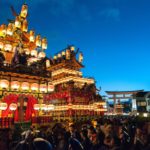Day 1 (7/22) – Tokyo/Kyoto
Welcome back to Japan! After landing at Haneda you’ll take the train straight to Kyoto where you will settle for the next week or so.
Day 2 (7/23) – Kyoto
We’ve kept this day free for you to take it easy after a long flight.
Day 3 (7/24) – Kyoto
Gion Matsuri is one of Kyoto’s biggest and longest running festivals, and has events all throughout the month of July. Dating back to year 869, is started as a religious ceremony to appease the gods during an epidemic outbreak. During the festival, a local boy is chosen as a messenger to the gods, and cannot set foot on the ground between the dates of 13th and 17th July. Although you will have missed the main float parade on the 17th, on the 24th of July the floats are returned to Yasaka shrine in a mini-parade. These hoko floats are the most impressive we’ve seen, some being up to 25m tall! The parade takes place in the morning. *We plan on arranging seated tickets for the Gion Matsuri parade.
Day 4 (7/25) - Osaka
Today you’ll enjoy the main events of the Tenjin Matsuri. First, mikoshi floats along with drummers and dancers parade through the streets, followed by the spirit of the deity in a gilded mikoshi float. Expect music, dancing, festival food and high energy as the city celebrates its festival. In the evening, the floats reach the river where they are loaded onto boats and paraded up and down the river. It culminates with a brilliant fireworks display, after which the deity is returned to Tenmangu shrine signifying the end of this year’s festival. *Note: we plan on arranging seated tickets for the boat parade portion of the festival.
Day 5 + 6 (7/26-7/27) – Kyoto
We will arrange the following activities for you over the next few days:
- Noh theatre workshop. A Noh master whose family has been doing this for generations will explain the history and the process behind Noh theatre. It’s incredibly fascinating. You will also have the chance to try working the puppets yourselves.
- Make your own onigawara. These fierce-looking tiles made of clay have historically been placed in residences, shrines and temples for protection. They have a long history in Japan and you can make your own to take home with you as a memento.
- Craft your own kogatana under the guidance of a master swordsmith. He will assist you in forging your own small blade from Japanese steel, after which you can engrave it with your name to take home with you at the end of your trip.
Day 7 (7/28) – Kyoto
You’ll shift gears a bit today with the Hiwatari Matsuri. This highly spiritual festival is held in the evening at Tanukidani Fudioin temple. Shugendo monks first burn goma prayer sticks in a fiery blaze. They then rake these ashes flat and proceed to walk over them barefoot before inviting any willing members of the public to do the same. *We will arrange for a private car to take you to and from the festival.
Day 8 (7/29) – Hakuba
Today you’ll take the train to Hakuba (approx. 5hr journey).
Day 9 (7/30) – Hakuba
Hakuba is not only a winter wonderland, but also a summer paradise. Set against the backdrop of a dramatic landscape, its scenery is absolutely beautiful. A private guide will meet you at your hotel and take you on a customised tour of some of the area’s attractions. This will include a visit to the Iwatake Lily Fields, as well as a canoe tour on Lake Aoki followed by lunch. If you're interested, you could also enjoy a short hike through the valley (this can be tailored to your preference for level and length). *We will arrange a private car for you today to make travel easier.
Day 10 (7/31) – Hakuba
Today is flexible. Relax at your hotel, head over to the onsen around Lake Kizaki, or explore a few sites which will have been recommended by your guide the day before based on your interests.
Day 11 (8/1) - Nagaoka
On Day 11 you’ll travel to Nagaoka by train. We won’t plan for anything else so there’s no need to rush.
Day 12 (8/2) - Nagaoka
Today might very well be one of the trip’s highlights as you get to experience one of the biggest fireworks festivals, and some argue the best, in the country. Going for almost 80 years, it was first started to honour those whose lives were lost during second world war. A whopping 85% of the city was bombed during this time. More recently they also make tribute to those lost during the 2004 earthquake. A couple of hours long and set to music in the evening, these fireworks take place along the Shinano river. There are also a few other events in the afternoon including a parade and lantern floating ceremony. *We plan on reserving tickets for you for the fireworks.
Day 13 (8/3) - Akita
You’ll travel to Akita by train today, which will take a few hours. The evening will be free for you to relax.
Day 14 (8/4) - Akita
Kanto Matsuri is another popular Tanabata-related festival. Huge poles are bedecked with lanterns, and participants take their turns balancing these in various ways. The poles starts small and gradually get bigger as those involved see who can get theirs the highest. The main pole lantern event happens in the evening, but there are also daytime events including the opportunity to balance your own min kanto poles. There are also kanto competitions during the day which are free to attend. *We plan on arranging seats for the main evening event.
Day 15 (8/5) - Aomori
Travel on to Aomori today for the final festival of on your itinerary.
Day 16 (8/6) - Aomori
When people think of festivals in Japan, the Nebuta Matsuri is often one of the first that comes to mind. One of the 3 great Tohoku festivals, it features giant floats depicting gods, historical figures or mythical creatures which are paraded through the streets accompanied by taiko drums, musicians and dancers. These floats are made of washi paper and wire, and can take an entire year to design and construct. Today’s event is an evening parade of some of the larger floats. You can also see these up close during the day where they are housed; if you’re lucky you may even be able to meet some of the designers. *We plan on arranging tickets for you for the evening parade.
Day 17 (8/7) - Aomori
On the final day of the Nebuta Matsuri, both large and small floats are paraded through the streets in the afternoon. You can even participate in the parade if you wish, although you would need to wear a traditional haneto dancing costume. Similar to Tenjin Masturi, floats are then loaded onto boats and floated up and down the river. The final event is a fireworks display which lights up the night sky, bringing this incredible festival to a close. *We plan on arranging tickets for the land and boat parades/fireworks.
Day 18 (8/8) - Aomori
Being so far north, it might make sense to fly out of Aomori to then continue travel back home. We’re happy to plan for whatever’s most convenient. We will arrange a car to take you from the hotel to the airport. We hope you’ve had an amazing time experiencing in so many of Japan’s summer festivals!







